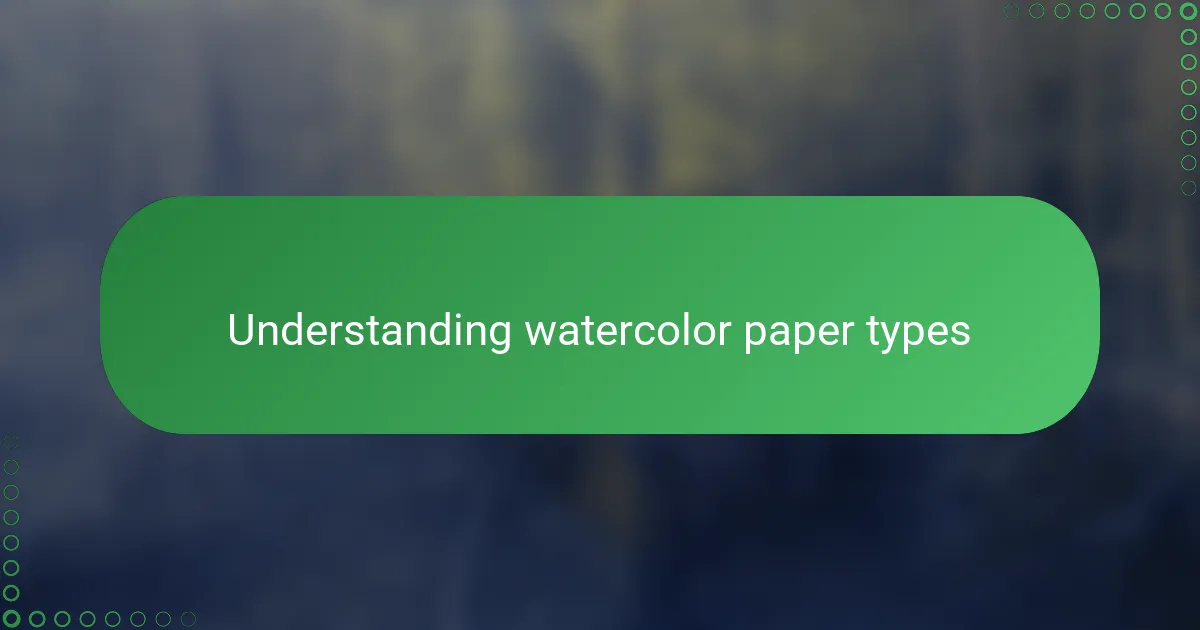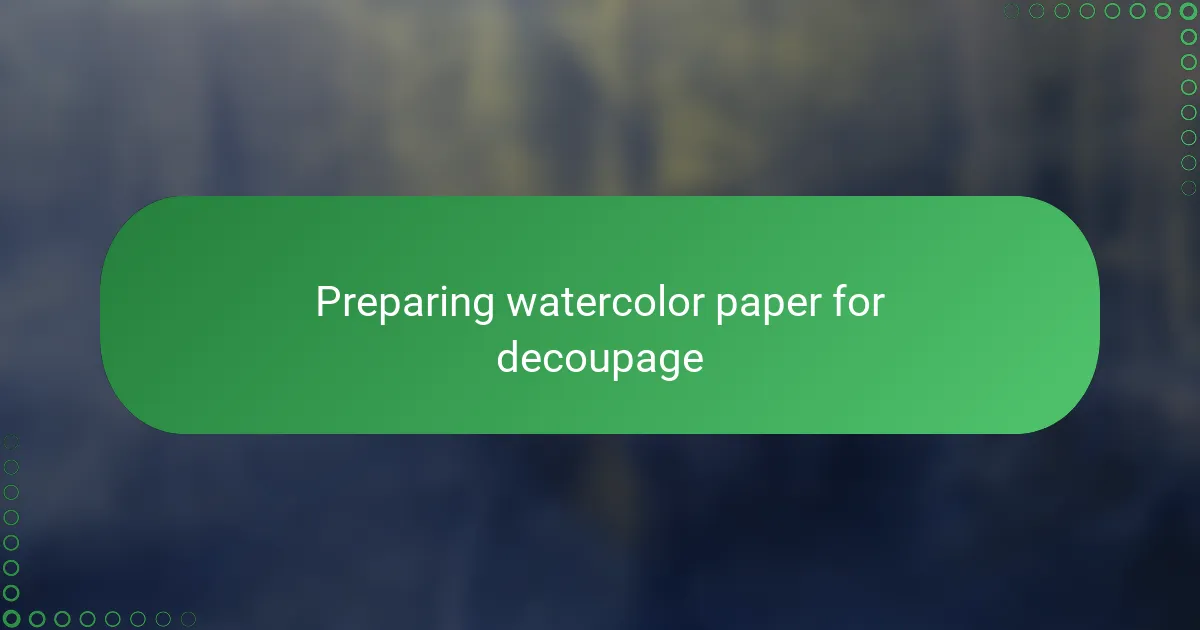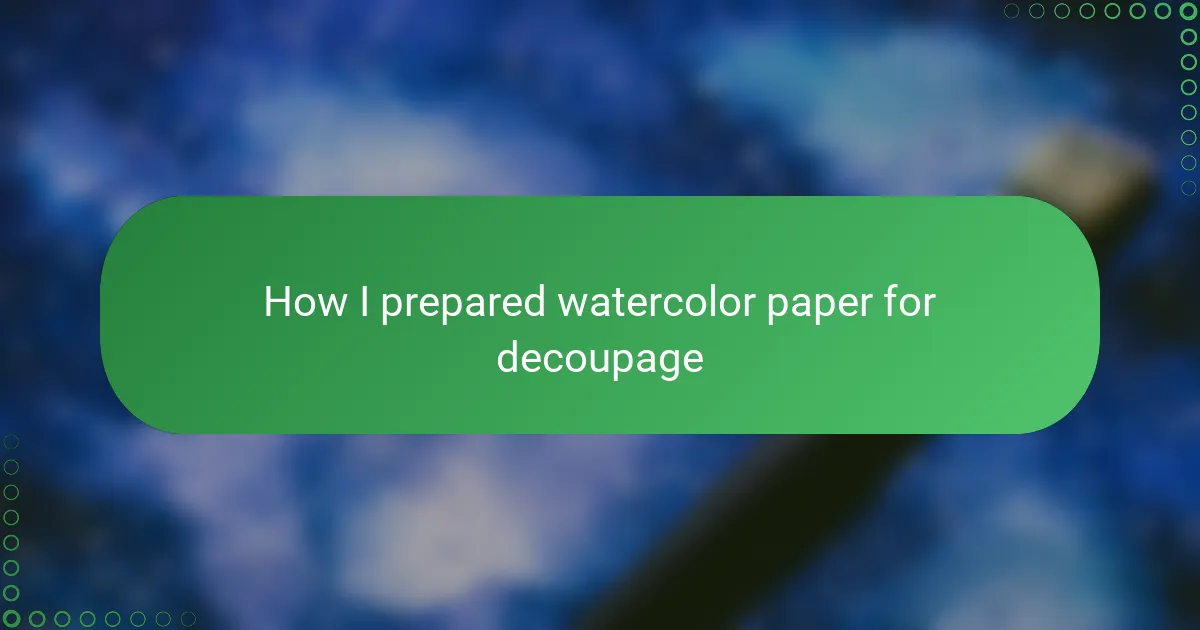Key takeaways
- Handmade paper crafts offer a tactile and meditative experience, encouraging mindfulness and creativity.
- Understanding the different types of watercolor paper (cold-pressed vs. hot-pressed) and their properties is crucial for successful decoupage.
- Preparing watercolor paper with thorough cleaning and priming using acrylic gesso significantly enhances the quality of the final project.
- Finishing touches, such as applying matte varnish and refining edges, elevate the overall aesthetic and durability of decoupage pieces.

Introduction to handmade paper crafts
Handmade paper crafts have always held a special place in my creative journey. There’s something uniquely satisfying about transforming simple sheets of paper into tangible works of art. Have you ever noticed how the texture and imperfections in handmade paper add character and depth, making each project truly one-of-a-kind?
When I first started exploring handmade paper crafts, I felt an immediate connection to the tactile experience—the slight roughness, the subtle variations in color. It’s a far cry from mass-produced paper, and that uniqueness fuels my inspiration every time. Don’t you think that crafting with handmade paper invites a slower, more thoughtful process that enriches the entire creative experience?
Beyond the aesthetic appeal, handmade paper crafts remind me of the beauty in patience and care. Every fold, tear, or brushstroke feels intentional, almost meditative. In a world that moves so fast, isn’t it refreshing to indulge in a craft that encourages mindfulness and respect for materials?

Understanding watercolor paper types
Watercolor paper comes in different types, each with its own texture and weight, which greatly influence how glue and paint interact. I remember being surprised the first time I used cold-pressed paper—it’s got this beautiful, slightly bumpy surface that holds moisture well without buckling too much. Have you noticed how that texture can make your decoupage projects look more dimensional and alive?
Then there’s hot-pressed paper, which feels smooth and almost creamy to the touch. At first, I thought the smoothness might be a drawback for layering paper, but actually, it allows for super crisp edges and fine detail work. It’s like choosing a canvas that matches your mood—sometimes I want rough and rustic, other times clean and polished.
And let’s not forget the paper weight—heavier paper generally means sturdier projects. I’ve learned the hard way that thin paper can warp or tear when wet, which is frustrating when you’re investing your time. So, understanding these types helps me pick the right paper that supports my vision, rather than working against it. How often do you think about these subtle differences before starting your project?

Preparing watercolor paper for decoupage
Preparing watercolor paper for decoupage starts with ensuring the surface is clean and free of any dust or loose fibers. I usually give my sheet a gentle wipe with a soft brush because even the tiniest particles can interfere with the glue’s ability to bond properly. Have you ever noticed how a perfectly prepped surface makes your layers stick better and prevents wrinkles?
Next, I like to lightly prime the paper with a thin layer of acrylic gesso. This step might seem extra, but from my experience, it strengthens the paper and creates a smooth base that handles glue and moisture much more predictably. If you skip priming, the glue can soak unevenly, causing unwanted textures that might ruin delicate details.
Finally, I always let the gesso dry completely before moving on, sometimes even giving it a gentle sanding to smooth out any bumps. It’s a little bit of extra patience, but I find this preparation pays off by giving the decoupage a crisp, professional finish. Have you tried this? It transforms the whole process from frustrating to fun.

Essential tools for preparation
When it comes to preparing watercolor paper for decoupage, having the right tools makes all the difference. I always keep a soft brush handy to gently sweep away any dust or stray fibers—trust me, it’s surprising how much those tiny particles can mess up the glue’s grip. Have you ever tried skipping this step, only to deal with frustrating bubbles and wrinkles later on?
Another essential in my prep kit is a good-quality acrylic gesso. Applying it carefully with a flat brush feels almost meditative, like giving the paper a protective hug before the creative chaos begins. I’ve found that using a wide, soft-bristled brush helps spread the gesso evenly, so there’s no risk of clumps or streaks that can spoil the surface.
Lastly, patience acts as an invisible tool in the preparation process. Waiting for the gesso to dry fully—and if I’m feeling particular, lightly sanding it—has transformed my decoupage from sloppy to sharp. Doesn’t that little extra effort make the whole project feel more like a labor of love?

Step by step preparation process
The first thing I do is lay my watercolor paper flat on a clean workspace and give it a gentle brush to remove any lingering dust or loose fibers. This simple step might seem minor, but I’ve found it makes a huge difference—have you ever noticed how even tiny particles can cause your glue to bubble or lift? Preparing the surface carefully sets a solid foundation for everything that follows.
After that, I apply a thin, even coat of acrylic gesso using a wide, soft brush. I remember thinking this was an extra task, but over time I’ve realized how much it strengthens the paper and controls how glue soaks in. Does it take a little patience? Sure. But letting the gesso dry fully keeps my layers smooth and manageable, which always makes me appreciate the effort later.
Sometimes, when I want an extra-smooth finish, I lightly sand the dried gesso with a fine grit sandpaper. This little bit of extra care really elevates the look of my decoupage pieces. Have you tried sanding before? It feels almost like a secret trick to getting those crisp, professional edges that make each project shine.

Troubleshooting common issues
One common hiccup I’ve faced is paper warping during glue application. At first, I thought it was just part of the process, but then I realized that uneven priming or applying glue too thickly was the culprit. Have you ever seen your carefully prepared sheet ripple like a pond? I learned that patience and thin, even layers can save the day.
Bleeding colors or wrinkling often sneak up when moisture isn’t controlled properly. I remember the frustration of my glue pool soaking too deeply, causing tiny bubbles that refused to smooth out. What helped me was allowing each layer to dry fully and using a sponge to gently press out excess moisture—simple steps that made a surprisingly big difference.
Sometimes, peeling or lifting happens despite my best efforts. It turns out that skipping surface cleaning or rushing the drying time were my biggest mistakes. Do you rush through prep sometimes? I’ve found taking those extra minutes to clean the paper and wait patiently pays off in smooth, durable finishes that don’t betray all that hard work.

Finishing touches for decoupage projects
When I’m finalizing a decoupage project, I always reach for a matte varnish to seal everything in. It’s amazing how a gentle coat not only protects the layers but also unifies the surface with a soft, elegant finish. Have you noticed how that finishing touch can take your piece from looking like a work-in-progress to a true masterpiece?
I also like to pay attention to the edges; carefully sanding or lightly buffing them can prevent peeling later on. There’s something satisfying about running your fingers along a smooth border, knowing you’ve added that extra layer of care. Isn’t it those little details that make all the difference between a good project and a great one?
Sometimes, I add a delicate wax or polish as the final flourish, which brings a subtle sheen and richness without overpowering the paper’s texture. It feels like giving your creation its own signature glow—like a whispered secret between the artist and observer. Have you ever used finishing touches that made your decoupage feel truly alive?
